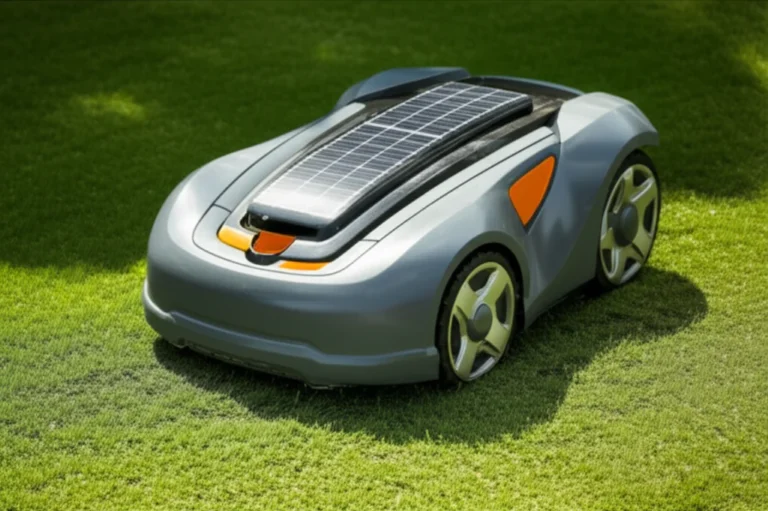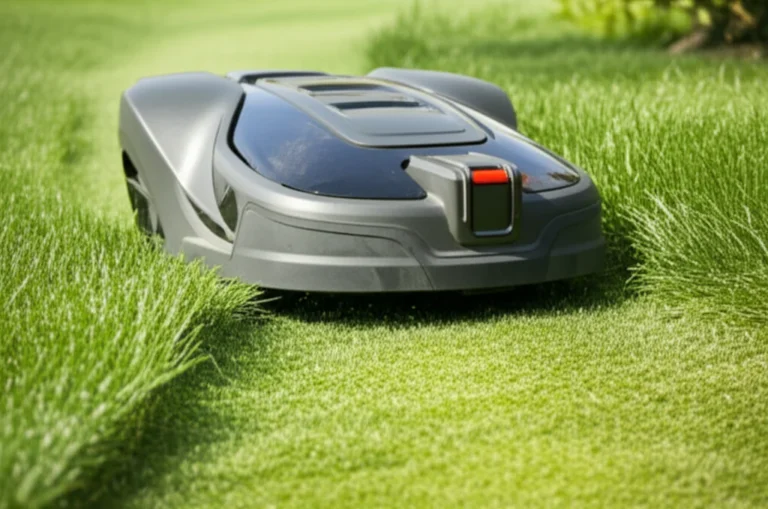Support our educational content for free when you purchase through links on our site. Learn more
Do All Robot Lawn Mowers Need a Boundary Wire? 🤖 (2025)
Imagine setting your robotic lawn mower loose on your yard, expecting it to trim every blade of grass perfectly—only to find it wandering into flower beds or, worse, your neighbor’s lawn! For years, boundary wires have been the invisible fences keeping robotic mowers on track, but with rapid advances in GPS, AI, and sensor tech, is that wire still a must-have? Spoiler alert: not all robot lawn mowers need a boundary wire, but whether you should ditch the wire depends on your lawn’s layout, size, and your appetite for tech.
In this deep dive, we’ll unravel the mystery behind boundary wires, explore cutting-edge wire-free navigation systems, and help you decide which mower style fits your yard like a glove. Curious about how AI-powered vision systems compare to trusty old wires? Or wondering if your complex garden can survive without a physical fence? Stick around—we’ve got the answers, plus expert tips and real-world brand recommendations to keep your lawn looking sharp all season long.
Key Takeaways
- Not all robotic lawn mowers require boundary wires; some use GPS, AI, or beacon systems for wire-free navigation.
- Boundary wires offer reliable, precise control and are ideal for complex or multi-zone lawns.
- Wire-free mowers provide easy installation and flexibility but may struggle in shaded or obstacle-dense yards.
- Top brands like Husqvarna, EcoFlow, and Mammotion offer both wired and wireless options tailored to different lawn needs.
- Choosing between wired and wire-free depends on your lawn’s size, complexity, and your budget.
Ready to find out which robotic mower style suits your yard best? Keep reading!
Table of Contents
- ⚡️ Quick Tips and Facts
- 🌿 The Great Lawn Debate: A Brief History of Robotic Mowing & Boundary Wires
- 🔗 The Wired World: Why Most Robot Mowers Still Love Their Boundary Wires
- 🔓 Breaking Free: Do All Robot Lawn Mowers Really Need a Boundary Wire?
- 📡 The Wireless Revolution: How Robot Mowers Navigate Without a Perimeter Wire
- 🚀 Unleashing the Untethered: Benefits of Wire-Free Robotic Mowing
- ⚔️ Choosing Your Champion: Wired vs. Wire-Free Robot Mowers – A Head-to-Head Battle
- 🔧 Installation & Setup: What to Expect (Wired & Wireless)
- 🚨 Troubleshooting Common Issues: Keeping Your Robot Mower Happy
- 🔮 The Future of Lawn Care: What’s Next for Robotic Mowers?
- ✅ Conclusion: Our Final Verdict on Boundary Wires
- 📚 Recommended Links: Dive Deeper into Robotic Mowing
- ❓ Your Burning Questions Answered: The FAQ Frontier
- 🔗 Reference Links: Our Sources & Further Reading
⚡️ Quick Tips and Facts
Welcome to the ultimate guide on whether all robot lawn mowers need a boundary wire! If you’ve ever wondered why some robotic mowers come with a spool of wire and others don’t, you’re in the right place. We at Robot Instructions™ have been knee-deep in robotic lawn care tech for years, and we’re here to spill the grass clippings on this topic.
Quick Facts to Mow You Over:
- ✅ Not all robotic mowers require a boundary wire. Some use GPS, AI, or sensors to navigate.
- ✅ Boundary wires create an electromagnetic fence that keeps the mower on your lawn.
- ❌ Wires can be damaged by animals, gardening tools, or weather, causing mower issues.
- ✅ Wire-free mowers often rely on GPS RTK, LiDAR, or camera-based vision systems.
- ❌ Wire-free tech can struggle in shaded or obstructed yards with complex layouts.
- ✅ Wired mowers usually find their charging station autonomously; some wireless models require manual return.
- ✅ Wire-free mowers offer easier installation and flexibility but may cost more upfront.
- ✅ Wired mowers are tried-and-true, especially for complex or multi-zone lawns.
Pro Tip from Our Robotics Engineers:
“Boundary wires are like invisible fences for your mower—reliable but sometimes a pain to install. Wire-free tech is the future, but it’s not a silver bullet yet.” — Robot Instructions™
Want to dive deeper? Check out our in-depth robot lawn mower guide for more expert insights.
🌿 The Great Lawn Debate: A Brief History of Robotic Mowing and Boundary Wires

Before we get into the nitty-gritty, let’s rewind a bit. Robotic lawn mowers have been around since the late 1990s, but the boundary wire has been the backbone of their navigation since day one.
Why Boundary Wires Became the Lawn’s Best Friend
- Early robotic mowers needed a precise, reliable way to know where to mow.
- Boundary wires emit a low-voltage electromagnetic signal that the mower detects to stay within limits.
- This system was simple, effective, and relatively cheap to implement.
The Installation Challenge
- Installing boundary wire involves laying a loop around the lawn’s perimeter and around obstacles.
- It requires planning, digging, and sometimes trial and error.
- Over time, wires can break or corrode, leading to troubleshooting headaches.
The Evolution of Alternatives
- As tech advanced, manufacturers started experimenting with GPS, AI, and sensor-based navigation.
- These innovations aim to eliminate the need for wires, making installation easier and more flexible.
For a fascinating timeline and the evolution of robotic lawn mowers, see this detailed history on Wikipedia.
🔗 The Wired World: Why Most Robot Mowers Still Love Their Boundary Wires
How Boundary Wires Work Their Magic 🪄
Boundary wires create an electromagnetic field that the mower’s sensors detect. When the mower approaches the wire, it senses the signal and changes direction, effectively “bouncing” off the invisible fence.
- The wire is connected to a boundary wire transmitter at the charging station.
- It forms a closed loop around the lawn and any no-go zones.
- The mower continuously scans for the wire signal to stay within bounds.
Pros and Cons of the Wired Approach ✅❌
| Pros | Cons |
|---|---|
| Reliable and precise boundary control | Installation can be time-consuming and tricky |
| Works in all weather and lighting conditions | Wire can be damaged by animals or tools |
| Allows multi-zone mowing with wire “gates” | Reinstallation needed if garden layout changes |
| Mower autonomously finds charging station | Wire can be a trip hazard or unsightly |
| Lower upfront cost compared to some wireless models | Troubleshooting wire breaks can be difficult |
Real-World Insight: Husqvarna Automower Boundary Wire
Our team has installed Husqvarna Automower boundary wires dozens of times. We recommend their black heavy-duty wire for durability (see the first YouTube video summary for a detailed explanation). It’s robust, UV-resistant, and holds up well underground.
🔓 Breaking Free: Do All Robot Lawn Mowers Really Need a Boundary Wire?
Short answer: No, not all robotic mowers need a boundary wire.
The Wire-Free Contenders
- GPS RTK-based mowers: Use satellite signals with centimeter-level accuracy.
- Vision and AI-based mowers: Use cameras, LiDAR, and machine learning to “see” the lawn.
- Beacon systems: Use strategically placed beacons to create virtual boundaries.
Why Some Still Prefer Wires
- Wire-free tech is still evolving and can struggle with:
- Dense tree cover or tall hedges blocking GPS signals.
- Complex lawns with many obstacles.
- Smaller or irregularly shaped yards.
Examples of Wire-Free Models
| Brand/Model | Navigation Method | Max Area Covered | Notable Features |
|---|---|---|---|
| EcoFlow BLADE | GPS + LiDAR + X-Vision AI | ~1000 m² | Smartphone app for boundary setup |
| Ambrogio Twenty ZR | Radar + AI grass detection | ~1000 m² | AI obstacle recognition |
| Husqvarna NERA | RTK GPS | 2200–5000 m² | Designed for large, open lawns |
| iRobot Terra T7 | Beacons + sensors | Medium | Requires professional beacon installation |
| Luba by Mammotion | 4WD + AI sensors | Up to 2000 m² | Handles steep slopes up to 75% gradient |
For more on wireless options, check out our Robotic Applications category.
📡 The Wireless Revolution: How Robot Mowers Navigate Without a Perimeter Wire
Let’s unpack the tech that’s freeing mowers from their wired shackles.
1. GPS & RTK Technology: Pinpoint Precision 🛰️
- GPS RTK (Real-Time Kinematic) uses a base station to correct satellite signals, achieving 2–5 cm accuracy.
- Allows mowers to know their exact position without wires.
- Challenges:
- Signal interference from buildings, trees, or weather.
- Requires power and communication between mower and base station.
- Used by brands like Husqvarna EPOS/NERA and Belrobotics for large lawns.
2. Vision Systems & AI: Seeing is Believing 👀
- Cameras combined with AI algorithms identify:
- Grass vs. non-grass areas.
- Obstacles like flower beds, pets, or toys.
- LiDAR sensors create 3D maps of the environment.
- Example: EcoFlow BLADE’s X-Vision system uses LiDAR + AI for precise navigation.
- Limitations include poor performance in low light or heavy rain.
3. Sensor Fusion & Advanced Algorithms: The Brains of the Operation 🧠
- Combines data from GPS, cameras, LiDAR, radar, and ultrasonic sensors.
- Enables the mower to make real-time decisions.
- Improves obstacle avoidance and path planning.
- Example: Ambrogio Twenty ZR uses radar and AI for grass detection and obstacle identification.
4. Beacon & Reference Point Systems: Guiding Lights ✨
- Beacons placed around the yard emit signals for localization.
- Mowers triangulate position relative to beacons.
- Used in models like iRobot Terra T7.
- Requires professional installation and clear yard layout.
🚀 Unleashing the Untethered: Benefits of Wire-Free Robotic Mowing
Why are manufacturers racing toward wire-free mowers? Here’s the scoop:
1. Installation Freedom: No More Digging! 🛠️
- No need to lay wire loops or worry about underground obstacles.
- Saves time, effort, and potential damage to existing landscaping.
- Perfect for renters or those who frequently redesign their yards.
2. Flexibility & Adaptability: Changing Landscapes Made Easy 🔄
- Boundaries can be adjusted via smartphone apps or beacon repositioning.
- Easier to add or remove zones without rewiring.
- Ideal for complex or multi-zone lawns.
3. Reduced Maintenance Headaches: Less Wire Woes 📉
- No wire breaks or corrosion.
- No risk of wire being cut by gardening tools or animals.
- Less troubleshooting and repair costs.
4. Enhanced Aesthetics: A Cleaner Look for Your Lawn 🏡
- No visible wires or stakes.
- No tripping hazards for kids or pets.
- Cleaner integration with other outdoor systems like irrigation or lighting.
5. Smart Home Integration & Future-Proofing 💡
- Many wire-free mowers integrate with smart home assistants (Alexa, Google Home).
- Can be controlled remotely via apps.
- Often include advanced scheduling, weather detection, and geofencing.
⚔️ Choosing Your Champion: Wired vs. Wire-Free Robot Mowers – A Head-to-Head Battle
Ready to pick your robotic lawn hero? Let’s compare the contenders.
Understanding Your Lawn’s Needs: Size, Complexity, & Obstacles 🌳
| Factor | Wired Mowers | Wire-Free Mowers |
|---|---|---|
| Lawn Size | Small to very large (multi-zone) | Medium to large (best in open areas) |
| Complex Layouts | Handles intricate boundaries well | May struggle with tight spaces |
| Obstacles | Wire protects flower beds, ponds | Relies on sensors; may need barriers |
| Multi-Zone Capability | Excellent with wire “gates” | Limited or requires beacons |
Budgeting for Brilliance: Cost Considerations 💰
- Wired mowers generally have lower upfront costs but require investment in wire and installation.
- Wire-free mowers tend to be more expensive upfront due to advanced tech.
- Maintenance costs for wired mowers can add up if wires break.
- Wire-free mowers may save on installation and repair but could require software updates or sensor calibration.
Top Brands & Models Leading the Charge (e.g., Husqvarna, Worx, Luba, Mammotion, Kress) 🏆
| Brand/Model | Wired or Wireless | Key Features | Coverage Area |
|---|---|---|---|
| Husqvarna Automower 315X | Wired | Boundary wire, GPS-assisted, app control | Up to 1600 m² |
| EcoFlow BLADE | Wireless | GPS RTK, LiDAR, X-Vision AI, app control | ~1000 m² |
| Worx Landroid M WR140 | Wired | Boundary wire, app scheduling | Up to 700 m² |
| Luba by Mammotion | Wireless | 4WD, AI navigation, steep slope handling | Up to 2000 m² |
| Kress Robot Mower | Wired | Boundary wire, multi-zone support | Varies |
👉 CHECK PRICE on:
- Husqvarna Automower on Amazon
- EcoFlow BLADE on Amazon
- Worx Landroid on Amazon
- Luba by Mammotion Kickstarter
- Kress Robot Mower on Amazon
🔧 Installation & Setup: What to Expect (Wired & Wireless)
Wired Wonders: A Step-by-Step Guide to Boundary Wire Installation 📏
- Plan Your Layout: Map out your lawn perimeter and obstacles.
- Lay the Wire: Use stakes or bury the wire 2-3 cm underground around the lawn edges.
- Connect to the Transmitter: Attach the wire ends to the charging station’s boundary wire terminal.
- Test Signal: Use the mower’s boundary wire signal tester to check for breaks.
- Secure and Cover: Bury the wire fully or secure it with lawn staples.
- Configure Zones: If you have multiple zones, create wire “gates” to allow mower access.
- Start Mowing: Program your mower schedule and let it go!
Pro Tip: Use Husqvarna’s black heavy-duty wire for durability and warranty coverage (see first YouTube video summary).
Wireless Wizards: Setting Up Your Wire-Free Mower with Ease 📱
- Download the App: Most wire-free mowers use smartphone apps for setup.
- Map Your Lawn: Use GPS or camera-based mapping to define mowing boundaries.
- Place Beacons (if required): Install beacons around the lawn for localization.
- Configure Zones & No-Go Areas: Use app tools to set virtual fences or restricted zones.
- Charge & Calibrate: Fully charge the mower and calibrate sensors as instructed.
- Start Mowing: Schedule mowing times and monitor progress remotely.
Note: Wireless setup is generally faster but requires good GPS signal or clear sightlines for cameras.
🚨 Troubleshooting Common Issues: Keeping Your Robot Mower Happy
Wire Breaks & Signal Loss (for wired models) 💔
- Symptoms: Mower stops at boundary, error codes, or won’t start.
- Use a wire fault detector to locate breaks.
- Check for damage from digging, pets, or lawn tools.
- Repair with wire connectors or replace sections.
- Regularly inspect wire condition, especially after storms.
GPS Drift & Obstacle Detection Glitches (for wireless models) 🚧
- Symptoms: Mower wanders off course, misses spots, or hits obstacles.
- Ensure clear GPS signal; trim overhanging branches if needed.
- Clean camera and sensor lenses regularly.
- Update firmware and calibrate sensors via the app.
- Place beacons correctly and avoid interference sources.
Battery Life & Charging Station Placement 🔋
- Position charging station on level ground with good signal reception.
- Keep station away from metal objects or water sources.
- Replace batteries every few years for optimal performance.
- Clean charging contacts regularly.
🔮 The Future of Lawn Care: What’s Next for Robotic Mowers?
The robotic lawn mower industry is evolving rapidly. Here’s what we foresee:
- Improved AI & Machine Learning: Smarter obstacle avoidance and grass detection.
- Hybrid Navigation: Combining boundary wires with GPS and vision for ultimate precision.
- Solar-Powered Models: Like the EcoFlow BLADE integrating solar charging for extended runtime.
- Integration with Smart Home Systems: Voice control, weather-aware scheduling, and lawn health monitoring.
- DIY & Open-Source Options: Projects like ArduMower and Alfred allow enthusiasts to customize their mowers.
- Environmental Sensors: Soil moisture and lawn health sensors to optimize mowing schedules.
For a deep dive into AI and machine learning in robotics, visit our Artificial Intelligence category.
📚 Recommended Links: Dive Deeper into Robotic Mowing
- EcoFlow BLADE Official Site
- Husqvarna Automower Series
- Ambrogio Robot Mowers
- iRobot Terra T7 Overview
- Robomow Boundary Wire Guide
- ArduMower DIY Robot Lawn Mower
❓ Your Burning Questions Answered: The FAQ Frontier

Q: Can I install a robotic mower without any wires at all?
A: Yes, but only if you choose a wire-free model with GPS or vision-based navigation. Keep in mind these models may require clear skies and fewer obstacles.
Q: What happens if my boundary wire breaks?
A: The mower may stop or get stuck at the break point. Use a wire fault detector to find and repair the break.
Q: Are wire-free mowers more expensive?
A: Generally, yes. The advanced tech and sensors add to the cost, but you save on installation and maintenance.
Q: Can wire-free mowers handle multi-zone lawns?
A: Some can, using beacons or app-based virtual boundaries, but wired mowers still excel at complex multi-zone setups.
Q: How do wire-free mowers find their charging station?
A: Some use GPS or vision to locate it autonomously; others may require manual placement.
For more FAQs, visit our Robotic Applications FAQ.
Next up: Final Thoughts and Verdict on Boundary Wires!
✅ Conclusion: Our Final Verdict on Boundary Wires

After mowing through the tangled grass of facts, tech, and user experiences, here’s the bottom line: not all robot lawn mowers need a boundary wire, but many still benefit from one.
Wired Robot Mowers: Tried, Tested, and Trusted
Pros:
- Reliable and precise boundary control — your mower won’t wander off or miss spots.
- Great for complex lawns and multi-zone setups with obstacles, flower beds, and ponds.
- Autonomous charging station return thanks to the wire loop.
- Lower upfront cost and easier troubleshooting.
Cons:
- Installation requires time, effort, and sometimes professional help.
- Wire damage from pets, tools, or weather can cause interruptions.
- Less flexible if you frequently redesign your garden.
Wire-Free Robot Mowers: The Future Is Here, But Not Perfect
Pros:
- Easy installation — no digging or wire-laying.
- Flexible boundaries adjustable via smartphone apps or beacons.
- Cleaner aesthetics with no visible wires or trip hazards.
- Advanced tech like GPS RTK, LiDAR, and AI for smart navigation.
Cons:
- Higher upfront cost due to sophisticated sensors and software.
- Performance can degrade in shaded areas or complex lawns.
- Some models require manual return to the charging station.
- Still maturing technology; occasional glitches possible.
Our Expert Recommendation
If you have a large, complex lawn with multiple zones or obstacles, a wired mower like the Husqvarna Automower 315X or Worx Landroid remains the most practical and reliable choice. The boundary wire ensures consistent performance and autonomous operation.
If you prefer ease of setup, flexibility, and cutting-edge tech, and your lawn is medium-sized and relatively open, consider wire-free models like the EcoFlow BLADE or Luba by Mammotion. These models offer exciting features like AI-powered navigation and app control but be prepared for a learning curve and occasional troubleshooting.
Remember: The best mower is the one that fits your lawn’s unique needs and your lifestyle. Boundary wires are not obsolete yet, but wire-free tech is rapidly closing the gap.
📚 Recommended Links: Dive Deeper into Robotic Mowing
Shop Robot Lawn Mowers & Accessories
-
Husqvarna Automower 315X:
Amazon | Husqvarna Official Website -
EcoFlow BLADE Robot Lawn Mower:
Amazon | EcoFlow Official Website -
Worx Landroid M WR140:
Amazon | Worx Official Website -
Luba by Mammotion:
Kickstarter | Mammotion Official Website -
Kress Robot Mower:
Amazon | Kress Official Website
Must-Read Books on Robotics and AI in Lawn Care
- Robotics: Modelling, Planning and Control by Bruno Siciliano et al. — Amazon Link
- Artificial Intelligence: A Modern Approach by Stuart Russell and Peter Norvig — Amazon Link
- Machine Learning for Robotics by Francis X. Govers — Amazon Link
❓ Your Burning Questions Answered: The FAQ Frontier
![Please enjoy this picture of an old tractor peeping over the near horizon, captured during the day at Lepton, UK. Photographed with a Fujifilm X-T3. For all enquiries, please contact me via Unsplash and I will endeavour to reply as soon as possible. Have a great day! [Rory Tucker / The Yorkshire Photographer] by Robot Instructions a tractor is parked in a field of green grass](https://images.unsplash.com/photo-1703610015208-1d2dd263722b?crop=entropy&cs=tinysrgb&fit=crop&fm=jpg&ixid=M3w0NDMxOTh8MHwxfHNlYXJjaHw3fHxyb2JvdCUyMGxhd24lMjBtb3dlciUyMGJvdW5kYXJ5JTIwd2lyZXxlbnwwfHx8fDE3NTk0MDA2MDN8MA&ixlib=rb-4.1.0&q=85&w=1200&h=630&auto=compress)
Are there robot lawn mowers that operate without boundary wires?
Absolutely! Several models use GPS RTK, AI-powered vision systems, or beacon technology to navigate without boundary wires. Examples include the EcoFlow BLADE, Ambrogio Twenty ZR, and Husqvarna NERA. However, these models often require open lawns with minimal obstructions and may have higher upfront costs. Wire-free mowers are ideal if you want quick setup and flexible boundaries but be aware that they may not yet match wired mowers in complex environments.
Read more about “7 Best Robot Lawn Mowers Without Perimeter Wire in 2025 🤖”
How does a boundary wire work with robot lawn mowers?
A boundary wire forms a closed loop around your lawn and obstacles, emitting a low-voltage electromagnetic signal. The mower’s sensors detect this signal and interpret it as a “fence,” preventing it from crossing the boundary. This system ensures precise mowing areas and safe navigation. The wire connects to the charging station, which powers the signal. If the wire breaks, the mower may stop or behave erratically until repaired.
Read more about “9 Reasons the Worx Landroid M 20V WR140 Will Transform Your Lawn in 2025 🌿”
What are the benefits of using a boundary wire for robot lawn mowers?
- Reliable and precise boundary control that works regardless of weather or lighting.
- Enables multi-zone mowing by creating wire “gates” between lawn sections.
- Allows the mower to autonomously find and dock at the charging station.
- Generally lower upfront cost compared to wire-free models.
- Easier troubleshooting since wire faults can be detected with specialized tools.
Read more about “5 Best Wire-Free Robot Lawn Mowers 🤖”
Can robot lawn mowers detect obstacles without a boundary wire?
Yes, many wire-free mowers use radar, LiDAR, cameras, and AI to detect and avoid obstacles like trees, pets, or toys. For example, the Ambrogio Twenty ZR uses radar and AI for grass and obstacle detection. However, these sensors may not be foolproof in all conditions, and some models still require physical barriers or beacons to prevent mowing over delicate areas.
Read more about “What is the Life of a Robot Mower? … 🤖🌱”
How difficult is it to install a boundary wire for a robot lawn mower?
Installing a boundary wire requires planning, measuring, and physically laying the wire around the lawn perimeter and obstacles. It can take a few hours to a day depending on lawn complexity. The wire can be buried or laid on the surface with stakes. While not overly difficult, it demands patience and some DIY skills. Professional installation is an option for those who want a hassle-free experience.
Are there alternative technologies to boundary wires for robot lawn mowers?
Yes! Alternatives include:
- GPS RTK systems: Provide centimeter-level positioning without wires.
- Vision-based navigation: Cameras and AI identify grass and obstacles.
- Beacon systems: Emit signals for localization without wires.
- Grass sensors: Detect grass areas but often require physical barriers.
Each has pros and cons, and some hybrid models combine wire and wireless tech for optimal performance.
Do boundary wires affect the performance of robot lawn mowers in uneven yards?
Boundary wires themselves do not directly affect performance on slopes or uneven terrain. However, the mower’s ability to handle slopes depends on its design and traction. Some models, like the Luba by Mammotion, can handle gradients up to 75%. Boundary wires simply define the mowing area regardless of terrain. Proper wire placement ensures the mower doesn’t venture into unsafe or unmanageable zones.
🔗 Reference Links: Our Sources & Further Reading
- EcoFlow BLADE Robot Lawn Mower Official Site
- Husqvarna Automower Series
- Ambrogio Robot Mowers
- iRobot Terra T7 Overview
- Robomow Boundary Wire vs. Grass Sensors
- ArduMower DIY Robot Lawn Mower Project
For more on AI and machine learning in robotics, visit our Artificial Intelligence category.
Thanks for sticking with us through this comprehensive journey! Whether you choose the trusty boundary wire or embrace the wireless future, your lawn is in good hands with today’s robotic mowers. Happy mowing! 🌱🤖






